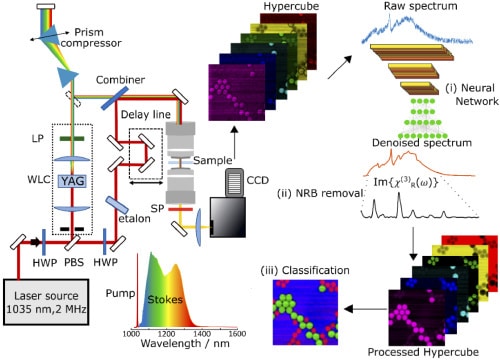Researchers demonstrated an innovative technique of label-free detection with fast and efficient imaging using coherent anti-stokes Raman scattering (CARS) microscopy

The images produced by CARS microscopy are dependent on vibrational signatures of molecules by disrupting the interaction between ultrashort laser pulses and biological samples. This new approach consists of a commercial laser that emits ultrashort pulses with durations of 270 femtoseconds in the near-infrared wavelength range. The conventional CARS systems use laser pulses with a repetition rate of 40 or 80 MHz while this new method uses only 2 MHz.
“The most important advantage of the lower repetition rate is that it allowed us to generate broadband, red-shifted Stokes pulses that cover the whole fingerprint vibrational region by using white-light supercontinuum generation in a bulk crystal,” said Federico Vernuccio, a doctoral student at Politecnico di Milano and first author of the study. “Compared to other methods, this approach is technically simpler, more compact, and robust.”
The researchers also invented new algorithms that involve artificial intelligence which helps in extracting more amount of information to construct an image that helps to distinguish various chemical species. It was also demonstrated that the new system has the ability to work on biological samples without causing any damage.
“Our CARS microscope allows label-free imaging with chemical specificity at higher speeds, thus making Raman imaging of living cells more feasible,” said Polli. “This could allow our system to be used to analyze the interactions of cancer cells with immune cells or to characterize how chemotherapy affects cells, for example.”
Further, the research is carried on to improvise the systems speed of imaging and the number of detectable chemical analytes by creating a broader wavelength range of Stokes pulses through white-light supercontinuum generation. They also aim to commercialize this product by making it user-friendly software, compact optical sources, and designs for a commercial prototype and detection system.
Click here for the published Research Paper







